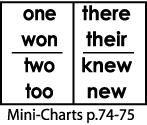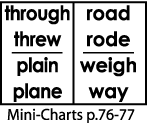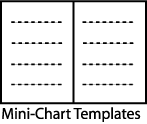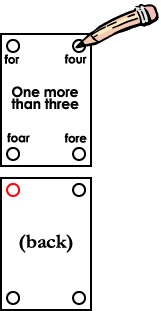





Homophones Lesson Plan
Same But Different
- Students will learn to recognize and spell words in homophone sets.
- Students will assign the correct meaning to each word in a homophone set.
A homophone is a word that has the same pronunciation as another word or words but that has a different meaning. Some common homophone are there/their/they’re, one/won, and hour/our. Sometimes words become homophones only in certain areas of the country based on local word pronunciations. For example, in some locations, words beginning with the letters w-h are pronounced the same as words beginning with the letter w ( where/wear, which/witch). Word spellings in some homophone sets differ only in punctuation (its/it’s, boys/boy’s). Because students frequently confuse the spellings of words in homophone sets, it is important to 1)learn the different ways that similar-sounding words are spelled, 2) learn the different meanings of words in homophone sets, and 3) associate each homophone spelling with its corresponding word meaning. In this song, students practice the spelling of different homophone sets. Once the spellings are learned, several activities are suggested for helping students to associate spellings and word meanings.
- Sing Your Way Through Phonics Volume 3 CD, Tracks 13 and 14 (Listen to audio sample)
- Sing Your Way Through Phonics Volume 3 Mini-Charts (pp. 73-78)
- Optional: Index cards
Note: If you do not have the CD or Mini-Charts, you can still teach this homophones lesson plan using the folk tune listed on the Same But Different Song Lyrics page. You can create your own mini-charts using the words in bold print letters in each verse of the Song Lyrics.
Find out more about Sing Your Way Through Phonics products.
Order our cost-saving Volume 3 Combo online.










- Without showing students the word in print, say, “Can anyone tell me the meaning of the word won (or too)? What else do you need to know before you can tell me the meaning of the word?” (You need to see the word written down or hear it in a sentence.) “Why do you need more information in order to spell some words correctly?” (Because some words sound the same but are spelled differently.) “Today, we are going to learn a song that helps us remember the different spellings of words that sound the same. We call these words homophones which means sound the same. Once we know the different spellings of words in homophone sets, it is important to know which spelling to choose when we are writing. We need to be sure that the spelling matches the meaning of the word.”
- Say, “Let’s look at some homophones.” Display Mini-Charts pp. 74-75. Ask, “Who can spell the word that means win in the past?” (w-o-n) “Who can spell the word that means double?” (t-w-o)
- Say, “We can remember how to spell homophone words if we link the spelling to the meaning of the word. For example, to remember the spelling of won, we can think of the related word, win and change only the middle letter.” Demonstrate this with plastic letters or letter tiles. “To remember how to spell the word two, we can remind ourselves that two means double and that there is a w (double-u) in the center of the word.”
- Say, “Let’s follow along and listen to some other homophone spellings. See if you can join in on the part that keeps repeating.” Play CD Track 13 (Same But Different) and point to the Mini-Charts on pages 74-77 when the words on those pages are spelled in the song.
- Say, “Now, let’s create some memory hooks for our homophone words. If we already know the spelling of both words in a homonym set, then we only need to have a memory hook for one of them. If the word we want doesn’t match the memory hook, then we’ll know to use the other spelling.”
- Look at Mini-Chart p. 74. Say, “We’ve talked about memory hooks for two of these words. Who can remember them?” (See Step 3.)
- Look at the top homophone set on Mini-Chart p. 75. Ask, “Which word means the opposite of here?” (t-h-e-r-e). “Our memory hook for this word is that it has the opposite word contained within it. You can’t spell there without spelling here. So, if we want to spell the word that means the opposite of here, how would we spell it?” (t-h-e-r-e)
- Look at the bottom homophone set on Mini-Chart p. 75. Ask, “Which means know in the past?” (k-n-e-w) “So, for our memory hook, we can think of the word know and change just one letter in the middle.”
- Look at the top homophone set on Mini-Chart p. 76. Ask, “Which word means throw in the past?” (t-h-r-e-w) “So, for our memory hook, we can think of the word throw and change just one letter in the middle.”
- Look at the bottom homophone set on Mini-Chart p. 76. Ask, “Which word has the word plan within it?” (p-l-a-n-e) “For our memory hook, we can think of the sentence, ’We plan to go by plane.’ The word plan and plane differ by just one letter; what is it?” (silent e at the end of plane)


- Practice singing Same But Different daily for a few days. Review memory hooks. Discuss meanings of each word in the homonym sets: one (single), won (past of win), two (double), too (also or more than is needed), there (opposite of here), their (belongs to them), knew (past of know), new (opposite of old), through (finished or in one side and out the other), threw (past of throw), plain (simple or grassland), plane (aircraft or flat surface), road (street or highway), rode (past of ride), weigh (determine how heavy), way (direction or method)
- Mention that some homonyms sets contain three words: there/their/they’re, two/too/to. Find memory hooks for one more word in each set. Examples:
- What does they’re mean? (they are) Memory hook: Think of they are and replace the a with an apostrophe.
- What does to mean? (opposite of from). How can we distinguish to from too? Memory hook: too has too many o’s

- Make a homonym dictionary, either individually or as a class. Illustrate with pictures or speech bubbles of people talking. Clarify word meanings by including them in sentences.
- Workshop or learning center activity: Create self-checking flashcards by punching a hole in each corner of index cards. Write a definition in the center of each card. Write four possible spellings in the corners. Poke a pencil through the right answer. On the back of the card, draw a circle around the correct hole.
- Play the Homonym Bingo spelling game. Fill up Bingo grids with homonym words. The caller reads definitions and the players cover or remove the word that goes with the definition. Test winners by asking for the definition of their winning words.
- Students will pass a spelling test on homonym sets, hearing each word in a sentence.
- Students will use correct homonym spellings as they occur naturally in their writing.
